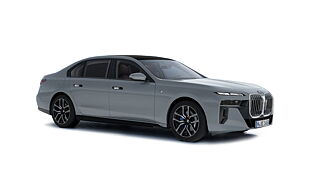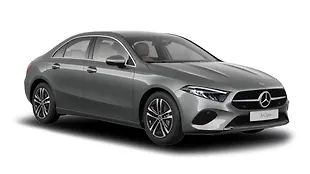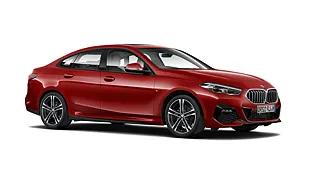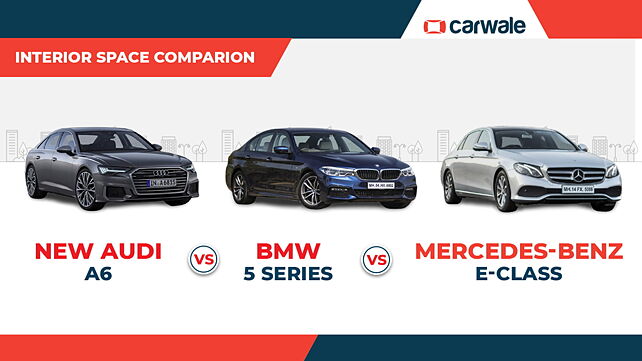
Audi has reinstated the mid-size executive sedan war with the introduction of the new-gen A6. The new-gen A6 is bigger, gets more features and is slightly spacious on the inside compared to the older model. We have already driven the new A6 and you can read all about it over here. But how does it stack up against its direct rivals namely – Mercedes-Benz E-Class and BMW 5 Series. Here we have a detailed comparison of the German trio in terms of interior space with dimensions that we at CarWale have measured ourselves. Read further to find out which of the three offers more space whether you want to drive the car or be chauffeured around.
In this comparison, we’ll look at seven aspects inside the cabin across all three models – legroom (max/min), ideal legroom, headroom (max/min), shoulder room, seat base length, seat backrest height, and ingress. All dimensions are in centimetres.
Front Row Space:

As you step inside the cabin, the first thing that you notice are the front seats. Front row space is among the important factors to consider before buying a new car. Although the executive sedans are mostly chauffeur-driven, they do pack in some sporty credentials with their name. So in the front row, we found that the A6 has the largest legroom of 90cms compared to 85cms offered in both the other cars. But the E-Class triumphs in ideal legroom category with 80cms as opposed to 75cms and 76cms in A6 and 5 Series respectively.

Taller drivers would be happy since Audi offers a headroom of 99/92cms (max/min with electrically adjustable seats). Meanwhile, the 5 Series and E-Class provide a headroom of 98/92cms and 97/89cms respectively. And when it comes to the shoulder room, at 147cms, the E-Class is the widest of the lot followed by 144cms in 5 Series and 138cms in the A6.

As for the seats, the E-Class also offers the maximum leverage of 57cms as opposed to 51cms in the 5 Series, while the A6 has the smallest seat base length of just 46cms. On the other hand, the 65cm seat backrest in the 5 Series makes it more comfortable as compared to the other two. What’s more, the Merc has a low ingress height of 63cms while the 5 Series is slightly higher at 65cms and the A6 has an ingress of 66cms. A higher ingress makes getting in and out of the vehicle much easier and less strenuous.
Rear Row Space:

Since these sedans are mostly chauffeur-driven, the car buyers would be spending most of their time on the backseat. No surprise here as Mercedes E-Class in its LWB guise has 96/70cms (max/min) of legroom. But the A6 isn’t too far behind offering a legroom of 95/60cms while 5 Series has 92/62cms of it. Even in the ideal legroom criteria, the E-Class offers the maximum at 82cms, while the A6 and the 5 Series come close at 80cms and 74cms, respectively.

On the other hand, A6 is better suited for rear passengers as it offers the maximum headroom of 95cms, while the BMW offers a marginally lesser headroom of 93cms. As compared to the other two, the E-Class has a stooping roofline which reduces the headroom to 89cms. Meanwhile, the E and 5 Series are the widest cars here with a shoulder room of 141cms in both of them while the A6 falls behind with its 136cms of shoulder room.

In terms of seat dimensions, 5 Series has 52cms of seat base length and 66cms of backrest height. Coming in second is A6 with a seat dimension of 46cms for base length and 66cms of backrest height. Despite offering the largest legroom, the E-Class has the smallest seat at the back which has a base length of 49cms and backrest height of 57cms. In terms of ingress, all three cars here are evenly matched.
Boot space:
Lastly, these mid-size executive sedans add practicality to their package with overly large boot space. Measuring 120x104x49cms in dimension (for length x width x height), the A6 has the largest boot of the trio. In the second place is the 5 Series whose boot measures 111x102x39cms. And the E-Class has the smallest boot of the lot with a dimension of 99x110x47cms. The loading lip height of all the three cars here is evenly matched at 67cms.

![BMW 5 Series [2017-2021] Image BMW 5 Series [2017-2021] Image](https://imgd.aeplcdn.com/272x153/cw/ec/26911/BMW-5-Series-Right-Front-Three-Quarter-172250.jpg?wm=0&q=80)
![Mercedes-Benz E-Class [2017-2021] Image Mercedes-Benz E-Class [2017-2021] Image](https://imgd.aeplcdn.com/272x153/n/cw/ec/22875/e-class-exterior-right-front-three-quarter-119151.jpeg?q=80)
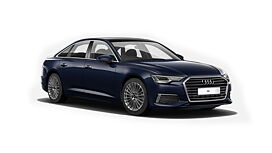
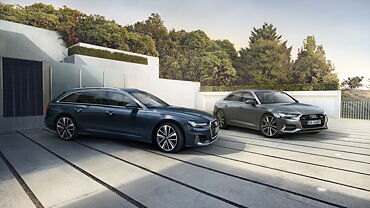

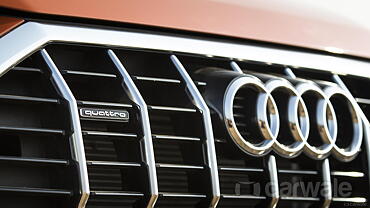




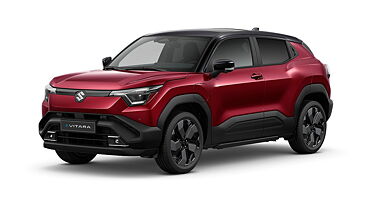


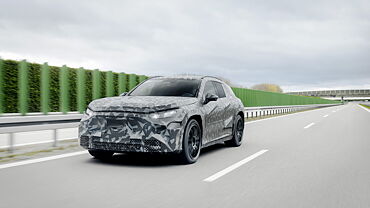




![BMW 5 Series [2017-2021] Right Front Three Quarter BMW 5 Series [2017-2021] Right Front Three Quarter](https://imgd.aeplcdn.com/199x112/cw/ec/26911/BMW-5-Series-Right-Front-Three-Quarter-172250.jpg?wm=0&q=80)
![BMW 5 Series [2017-2021] Right Front Three Quarter BMW 5 Series [2017-2021] Right Front Three Quarter](https://imgd.aeplcdn.com/199x112/cw/ec/26911/BMW-5-Series-Right-Front-Three-Quarter-101056.jpg?v=201711021421&q=80)
![BMW 5 Series [2017-2021] Front View BMW 5 Series [2017-2021] Front View](https://imgd.aeplcdn.com/199x112/cw/ec/26911/BMW-5-Series-Front-view-102015.jpg?v=201711021421&q=80)
![BMW 5 Series [2017-2021] Interior BMW 5 Series [2017-2021] Interior](https://imgd.aeplcdn.com/199x112/cw/ec/26911/BMW-5-Series-Interior-102016.jpg?v=201711021421&q=80)
![BMW 5 Series [2017-2021] Interior BMW 5 Series [2017-2021] Interior](https://imgd.aeplcdn.com/468x263/cw/ec/26911/BMW-5-Series-Interior-102028.jpg?v=201711021421&q=80)








